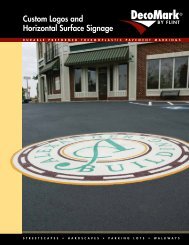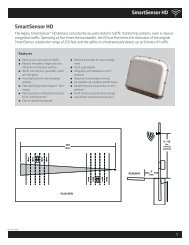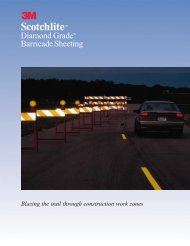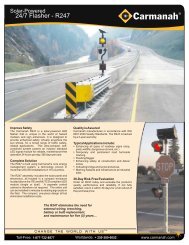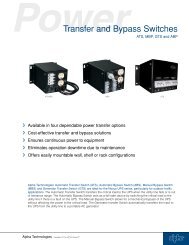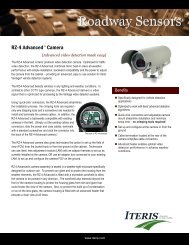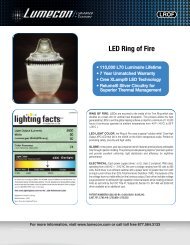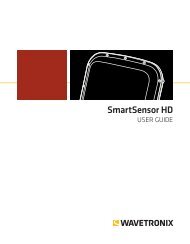Wavetronix SmartSensor Matrix - Interprovincial Traffic Services
Wavetronix SmartSensor Matrix - Interprovincial Traffic Services
Wavetronix SmartSensor Matrix - Interprovincial Traffic Services
You also want an ePaper? Increase the reach of your titles
YUMPU automatically turns print PDFs into web optimized ePapers that Google loves.
<strong>SmartSensor</strong> <strong>Matrix</strong><br />
<strong>SmartSensor</strong> <strong>Matrix</strong> Installation Specification<br />
1.0 General. This item shall govern the installation of an aboveground radar presence detector (RPD) equivalent to the <strong>Wavetronix</strong><br />
<strong>SmartSensor</strong> <strong>Matrix</strong>.<br />
RPDs can provide accurate, consistent, and reliable presence detections provided they are installed properly. The requirements in<br />
this specification are intended to ensure proper RPD installation.<br />
2.0 Mounting and Installation.<br />
2.1 Mounting Assembly. The RPD shall be mounted directly onto a mounting assembly fastened to a mast arm, pole or<br />
other solid structure.<br />
The RPD mounting assembly shall provide the necessary degrees of rotation to ensure proper installation.<br />
The RPD mounting assembly shall be constructed of weather-resistant materials and shall be able to support a 20-lb. (9.1-<br />
kg) load.<br />
2.2 Mounting Location. The RPD shall be mounted at a height that is within the manufacturer’s recommended mounting<br />
heights.<br />
The RPD shall be mounted at an offset from the first lane that is consistent with the RPD’s minimum offset.<br />
The RPD shall be mounted so that at least 20 feet along the farthest lane to be monitored is within the field view of the<br />
RPD.<br />
The RPD shall be mounted with its cable connector down and shall be tilted so that the RPD is aimed at the center of the<br />
lanes to be monitored. Typically, the RPD is tilted off of vertical by 20–30 degrees.<br />
The RPD shall be mounted on a vertical signal pole or on the horizontal mast arm.<br />
The RPD shall be mounted so that its field of view is not occluded by poles, signs or other structures.<br />
RPDs that are mounted within 20 ft. (6.1 m) of each other or that are monitoring the same intersection shall be configured<br />
to operate on different RF channels regardless of the pointing direction of the RPDs.<br />
It is recommended that the manufacturer be consulted to verify final RPD placement if the RPD is to be mounted near<br />
large planar surfaces (sound barrier, building, parked vehicles, etc.) that run parallel to the monitored roadway.<br />
2.3 Cabling. The cable end connector shall meet the MILC- 26482 specification and shall be designed to interface with<br />
the appropriate MIL-C-26482 connector. The connector backshell shall be an environmentally sealed shell that offers<br />
excellent immersion capability. All conductors that interface with the connector shall be encased in a single jacket, and the<br />
outer diameter of this jacket shall be within the backshell’s cable O.D. range to ensure proper sealing. The backshell shall<br />
have a strain relief with enough strength to support the cable slack under extreme weather conditions. Recommended connectors<br />
are Cannon’s KPT series, and recommended backshells are Glenair Series 37 cable sealing backshells.<br />
The cable shall be the Orion Wire Combo-2204-2002-PVCGY or an equivalent cable that conforms to the following<br />
specifications:<br />
• The RS-485 conductors shall be a twisted pair.<br />
• The RS-485 conductors shall have nominal capacitance conductor to conductor of less than 40 pF/ft at 1 kHz.<br />
• The RS-485 conductors shall have nominal conductor DC resistance of less than 16.7 ohms/1000 ft. (304.8 m) at<br />
68°F (20°C).<br />
• The power conductors shall be one twisted pair with nominal conductor DC resistance of less than 11.5 ohms/1000 ft.<br />
11



